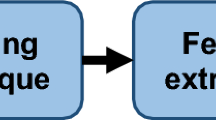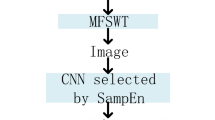Abstract
Heart diseases have a great impact on human health. Heart sound signals contain a lot of useful information about heart diseases. Therefore, various heart diseases can be judged by heart sound auscultation. In order to improve the accuracy of classification and judgment, a heart sound signal classification method based on the mixed characteristics of Mel cepstrum coefficient and second-order spectrum is proposed: first, a class of normal heart sounds and aortic stenosis, mitral regurgitation, mitral stenosis, mitral valve prolapse. The Mel cepstrum coefficients and second-order spectral features of four kinds of abnormal heart sounds with mitral valve prolapse are extracted separately and then combined into a new feature. The convolution neural network is used for learning and classification. The whole data set has a total of 1000 audio records, which are randomly divided into test sets and training sets by 2:3. From the experimental results, it can be seen that the accuracy rate in the training set is 99.6%, and the accuracy rate in the test set is 98.5%. Compared with other traditional classification and recognition methods, the accuracy is significantly improved.


















Similar content being viewed by others
Data Availability Statement
The data that support the findings of this study are available from the corresponding author on request.
References
N. Ahmed, T. Natarajan, K.R. Rao, Discrete cosine transform. IEEE Trans. Comput. 100(1), 90–93 (1974)
A.M. Alqudah, H. Alquran, I.A. Qasmieh, Classification of heart sound short records using bispectrum analysis approach images and deep learning. Netw. Model. Anal. Health Informat. Bioinformat. 9, 1–16 (2020)
W. Astuti, W. Sediono, A.M. Aibinu, R. Akmeliawati, M.J.E. Salami, Adaptive short time fourier transform (STFT) analysis of seismic electric signal (SES): a comparison of hamming and rectangular window (2012). https://doi.org/10.1109/ISIEA.2012.6496663
O. Russakovsky, J. Deng, H. Su, J. Krause, S. Satheesh, S. Ma., Z. Huang, A. Karpathy, A. Khosla, M. Bernstein, A.C. Berg, L. Fei-Fei, Imagenet large scale visual recognition challenge. Int. J. Comput. Vis. 115, 211–252 (2015)
D.R. Brillinger, An introduction to polyspectra. in Selected Works of David Brillinger (Springer, New York, NY, 2011), pp. 149–172
S. Davis, P. Mermelstein, Comparison of parametric representations for monosyllabic word recognition in continuously spoken sentences. IEEE Trans. Acoust., Speech, Signal Process. 28(4), 357–366 (1980)
S.-W. Deng, J.-Q. Han, Towards heart sound classification without segmentation via autocorrelation feature and diffusion maps. Fut. Gener. Comput. Syst. 60, 13–21 (2016)
M. Deng, T. Meng, J. Cao, S. Wang, J. Zhang, H. Fan, Heart sound classification based on improved mfcc features and convolutional recurrent neural networks. Neural Netw. 130, 22–32 (2020)
S.K. Ghosh, R.N. Ponnalagu, R.K. Tripathy, U.R. Acharya, Auto mated detection of heart valve diseases sing chirplet transform and multiclass composite classifer with PCG signals. Comput. Biol. Med. 118, 103632 (2020). https://doi.org/10.1016/j.compbiomed.2020.103632
K.M. Gaikwad, M.S. Chavan, Removal of high frequency noise from ECG signal using digital IIR Butterworth filter (IEEE, 2014), pp. 121–124
D.P. Kingma, J. Ba, Adam: a method for stochastic optimization. arXiv preprint arXiv:1412.6980 (2014)
A. Krizhevsky, I. Sutskever, G.E. Hinton, Imagenet classification with deep convolutional neural networks. Commun. ACM 60(6), 84–90 (2017)
M. Lam, T. Lee, P. Boey, W. Ng, H. Hey, K. Ho, P. Cheong, Factors influencing cardiac auscultation proficiency in physician trainees. Singap. Med. J. 46(1), 11 (2005)
S. McCandless, An algorithm for automatic formant extraction using linear prediction spectra. IEEE Trans. Acoust., Speech, Signal Process. 22(2), 135–141 (1974)
C.L. Nikias, M.R. Raghuveer, Bispectrum estimation: a digital signal processing framework. Proc. IEEE 75(7), 869–891 (1987). https://doi.org/10.1109/PROC.1987.13824
World Health Organization, Waist circumference and waist-hip ratio: report of a WHO xpert consultation, Geneva, 8–11 December 2008 (2011)
J.R. Quinlan, Induction of decision trees. Mach. Learn. 1, 81–106 (1986)
G.A. Roth, C. Johnson, A. Abajobir, F. Abd-Allah, S.F. Abera, G. Abyu, M. Ahmed, B. Aksut, T. Alam, K. Alam et al., Global, regional, and national burden of cardiovascular diseases for 10 causes, 1990 to 2015. J. Am. Coll. Cardiol. 70(1), 1–25 (2017)
Y. Ruan, Y. Guo, Y. Zheng, Z. Huang, S. Sun, P. Kowal, Y. Shi, F. Wu, Cardiovascular disease (CVD) and associated risk factors among older adults in six low-and middle-income countries: results from sage wave 1. BMC Public Health 18(1), 1–13 (2018)
K. Simonyan, A. Zisserman, Very deep convolutional networks for large-scale image recognition. arXiv preprint arXiv:1409.1556 (2014)
D.B. Springer, L. Tarassenko, G.D. Clifford, Logistic regression-HSMM-based heart sound segmentation. IEEE Trans. Biomed. Eng. 63(4), 822–832 (2015)
S.L. Strunic, F. Rios-Gutiérrez, R. Alba-Flores, G. Nordehn, S. Burns, Detection and Classification of Cardiac Murmurs using Segmentation Techniques and Artificial Neural Networks (IEEE, 2007), pp. 397–404
S. Sun, Z. Jiang, H. Wang, Y. Fang, Automatic moment segmentation and peak detection analysis of heart sound pattern via short-time modified Hilbert transform. Comput. Methods Programs Biomed. 114(3), 219–230 (2014)
G.-Y. Yaseen, S. Son, Kwon, Classification of heart sound signal using multiple features. Appl. Sci. 8(12), 2344 (2018)
S. Yuenyong, A. Nishihara, W. Kongprawechnon, K. Tungpimolrut, A framework for automatic heart sound analysis without segmentation. Biomed. Eng. Online 10, 1–23 (2011)
Acknowledgements
This research work was supported by the National Nature Science Foundation of China under Grant 61771176 and Grant 61801154.
Author information
Authors and Affiliations
Corresponding author
Ethics declarations
Conflict of Interest
The authors declare that they have no conflict of interest.
Additional information
Publisher's Note
Springer Nature remains neutral with regard to jurisdictional claims in published maps and institutional affiliations.
Rights and permissions
Springer Nature or its licensor (e.g. a society or other partner) holds exclusive rights to this article under a publishing agreement with the author(s) or other rightsholder(s); author self-archiving of the accepted manuscript version of this article is solely governed by the terms of such publishing agreement and applicable law.
About this article
Cite this article
Zhang, X., Liu, X. & Liu, G. A Heart Sound Signal Classification Method Based on the Mixed Characteristics of Mel Cepstrum Coefficient and Second-Order Spectrum. Circuits Syst Signal Process (2024). https://doi.org/10.1007/s00034-023-02588-9
Received:
Revised:
Accepted:
Published:
DOI: https://doi.org/10.1007/s00034-023-02588-9




